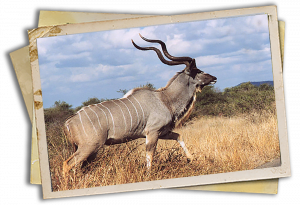

Range
Japan
African Kudu
Lesser kudu, Tragelaphus imberbis
Greater kudu, Tragelaphus strepsiceros
Two species of spiral-horned antelopes (tribe Tragelaphini, family Bovidae). The very large greater kudu (Tragelaphus strepsiceros) is common in southern African wildlife reserves. The svelte lesser kudu (T. imberbis) is an elusive dweller in the arid lowland thornbush of northeast and East Africa. Both species have corkscrew horns (in males only), depend on cover for food and concealment, and form small herds.
The greater kudu also has white forelegs with dark garters and a black-tipped tail. Males have a beard, turn darker with age, and possess the longest horns of any antelope: 120–180 cm (47–71 inches) along the curve. These horns take six years of growth to complete two full turns; the horn’s size and shape keep pace with and advertise the dominance status of the bearer.
The lesser kudu is vividly marked with 11–15 vertical white stripes, broad chest and throat patches, a nose chevron, and cheek patches. The legs are tawny and decorated with black and white patches, the tail is bushy with a white underside and a black tip, and there is a short, erectile dorsal crest but no beard.
The horns of mature males make two and a half (rarely three) turns and mesure 60–90 cm (24–35 inches) along the outer curve.
Both kudus are cover-dependent browsers that feed on more than 100 different trees, shrubs, vines, herbs, seedpods, and fruits, as well as a little new grass. Eating greens enables them to inhabit waterless country, yet greater kudus regularly drink at water holes. Both species depend on the green growth along watercourses in the dry season and disperse through deciduous woodlands in the rains.




